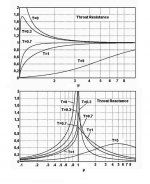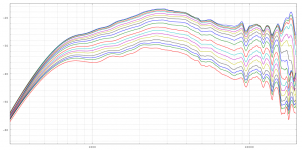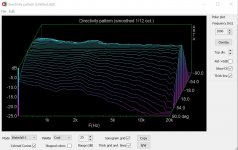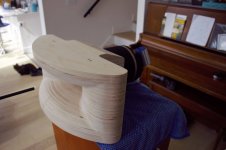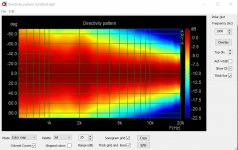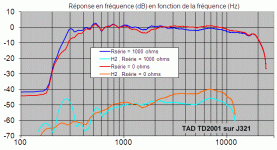My thoughts regarding Synergy/mehs/unity horns....mind you I have no idea how to differentiate them....Is that the midrange SQ is better on a 15" mid woofer or large horn+large format CD
I base this theory on Sd involved. lack of loading, and Source size via port/holes that hide the mid woofers.
Well, depending on what you call midrange (i'll use the REW bands on the main SPL/Phase tab... so 250Hz to 2 kHz) and stepping away from synergies, i think big cones like a 15", even a 12", starting loosing clarity above maybe 700 Hz or so.
So i'm all for a CD/horn combo reaching at least down to there.
Big question in my mind is whether a large horn+large format CD is better taken down really low, than using smaller cone mids to bridge to up to a higher CD xover point. (using small mids from say 250Hz up)
So far, on my latest syn builds which have added small mids to raise the CD cross point, i say resoundingly no to the lower CD idea so prevalent today....
But maybe that's just the syn/meh magic working...dunno...
Once again...
THE PURPOSE OF A HORN
It can be useful to look at the purpose of the horn before looking at the theory. Where are horns used, and for what?
Throughout the history of electroacoustics, there have been two important
aspects:
• Loading of the driver
• Directivity control
You would also think that increasing the output would be one aspect of horns, but this is included in both. Increasing the loading of the driver over that of free air increases efficiency and hence the output, and concentrating the sound into a certain solid angle increases the output further.
Loading of the Driver
The loudspeaker, which is a generator of pressure, has an internal source impedance and drives an external load impedance. The air is the ultimate load, and the impedance of air is low, because of its low density.
The source impedance of any loudspeaker, on the other hand, is high, so there will be a considerable mismatch between the source and the load. The result is that most of the energy put into a direct radiating loudspeaker will notreach the air, but will be converted to heat in the voice coil and mechanical resistances in the unit. The problem is worse at low frequencies, where the size of the source will be small compared to a wavelength and the source will merely push the medium away. At higher frequencies, the radiation from the source will be in the form of plane waves that do not spread out. The load, as seen from the driver, is at its highest, and the system is as efficient as it can be. If you could make the driver radiate plane waves in its entire operating range, efficient operation would be secured at all frequencies. The driver would work into a constant load, and if this load could be made to match the impedances of the driver, resonances would be suppressed.
This is because the driver is a mechanical filter, which needs to be terminated in its characteristic impedance, ideally a pure resistance. If the driver is allowed to radiate plane waves, resistive loading is secured. The easiest way to make the driver radiate plane waves is to connect it to a long, uniform tube. But the end of the tube will still be small compared to a wavelength at low frequencies. To avoid reflections, the cross section of the tube must be large compared to a wavelength, but, at the same time, it must also be small to fit the driver and present the required load. To solve this dilemma, you need to taper the tube.
When you do this, you can take radiation from the driver in the form of plane waves and transform the high pressure, low velocity vibrations at the throat into low pressure, high velocity vibrations that can efficiently be radiated into the air. Depending on how the tube flares, it is possible to present a load to the driver that is constant over a large frequency range.
Directivity Control
The directivity of a cone or dome diaphragm is largely uncontrolled, dictated by the dimensions of the diaphragm, and heavily dependent on frequency, becoming sharper and sharper as frequency increases.
You can solve this problem by using multiple driving units and digital signal processing, but a far simpler and cheaper way to achieve predictable directivity control is to use a horn. The walls of the horn will restrict the spreading of the sound waves, so that sound can be focused into the areas where it is needed, and kept out of areas where it is not.
Directivity control is most important in sound reinforcement systems, where a large audience should have the same distribution of low and high frequencies, and where reverberation and reflections can be a problem. In a studio or home environment, this is not as big a problem.
WHAT IS CUTOFF?
Both exponential and hyperbolic horns have a property called cutoff. Below this frequency, the horn transmits nothing, and its throat impedance impedance is purely reactive. But what happens at this frequency? What separates the exponential and hyperbolic horns from the conical horn that does not have a cutoff frequency?
To understand this, you first must look at the difference between plane and spherical waves. A plane wave propagating in a uniform tube will not have
any expansion of the wave-front. The normalized acoustical impedance is uniform and equal to unity through the entire tube.
A propagating spherical wave, on the other hand, has an acoustical impedance that changes with frequency and distance from the source.
At low frequencies and small radii, the acoustical impedance is dominated by reactance. When kr = 1—i.e., when the distance from the source is λ/2π —the reactive
and resistive parts of the impedance are equal, and above this frequency, resistance dominates.
The difference between the two cases is that the air particles in the spherical wave move apart as the wave propagates; the wave-front becomes stretched.
This introduces reactance into the system, because you have two components in the propagating wave: the pressure that propagates outward, and the pressure that stretches the wave-front. The propagating pressure is the same as in the non-expanding plane wave, and gives the resistive component of the impedance.
The stretching pressure steals energy from the propagating wave and stores it, introducing a reactive component where no power is dissipated. You can
say that below kr = 1, there is reactively dominated propagation, and above kr = 1 there is resistive dominated propagation.
If you apply this concept to the conical and exponential horns by looking at how the wave-fronts expand in these two horns, you will see why the cutoff phenomenon occurs in the exponential horn. You must consider the flare rate of the horn, which is defined as (rate of change of wave-front area with distance)/(wave-front area).
In a conical horn, the flare rate changes throughout the horn, and the point where propagation changes from reactive to resistive changes with frequency throughout the horn.
In an exponential horn, the flare rate is constant. Here the transition from reactive to resistive wave propagation happens at the same frequency throughout the entire horn. This is the cutoff frequency. There is no gradual transition, no frequency dependent change in propagation type, and that’s why the change is so abrupt.
THE PURPOSE OF A HORN
It can be useful to look at the purpose of the horn before looking at the theory. Where are horns used, and for what?
Throughout the history of electroacoustics, there have been two important
aspects:
• Loading of the driver
• Directivity control
You would also think that increasing the output would be one aspect of horns, but this is included in both. Increasing the loading of the driver over that of free air increases efficiency and hence the output, and concentrating the sound into a certain solid angle increases the output further.
Loading of the Driver
The loudspeaker, which is a generator of pressure, has an internal source impedance and drives an external load impedance. The air is the ultimate load, and the impedance of air is low, because of its low density.
The source impedance of any loudspeaker, on the other hand, is high, so there will be a considerable mismatch between the source and the load. The result is that most of the energy put into a direct radiating loudspeaker will notreach the air, but will be converted to heat in the voice coil and mechanical resistances in the unit. The problem is worse at low frequencies, where the size of the source will be small compared to a wavelength and the source will merely push the medium away. At higher frequencies, the radiation from the source will be in the form of plane waves that do not spread out. The load, as seen from the driver, is at its highest, and the system is as efficient as it can be. If you could make the driver radiate plane waves in its entire operating range, efficient operation would be secured at all frequencies. The driver would work into a constant load, and if this load could be made to match the impedances of the driver, resonances would be suppressed.
This is because the driver is a mechanical filter, which needs to be terminated in its characteristic impedance, ideally a pure resistance. If the driver is allowed to radiate plane waves, resistive loading is secured. The easiest way to make the driver radiate plane waves is to connect it to a long, uniform tube. But the end of the tube will still be small compared to a wavelength at low frequencies. To avoid reflections, the cross section of the tube must be large compared to a wavelength, but, at the same time, it must also be small to fit the driver and present the required load. To solve this dilemma, you need to taper the tube.
When you do this, you can take radiation from the driver in the form of plane waves and transform the high pressure, low velocity vibrations at the throat into low pressure, high velocity vibrations that can efficiently be radiated into the air. Depending on how the tube flares, it is possible to present a load to the driver that is constant over a large frequency range.
Directivity Control
The directivity of a cone or dome diaphragm is largely uncontrolled, dictated by the dimensions of the diaphragm, and heavily dependent on frequency, becoming sharper and sharper as frequency increases.
You can solve this problem by using multiple driving units and digital signal processing, but a far simpler and cheaper way to achieve predictable directivity control is to use a horn. The walls of the horn will restrict the spreading of the sound waves, so that sound can be focused into the areas where it is needed, and kept out of areas where it is not.
Directivity control is most important in sound reinforcement systems, where a large audience should have the same distribution of low and high frequencies, and where reverberation and reflections can be a problem. In a studio or home environment, this is not as big a problem.
WHAT IS CUTOFF?
Both exponential and hyperbolic horns have a property called cutoff. Below this frequency, the horn transmits nothing, and its throat impedance impedance is purely reactive. But what happens at this frequency? What separates the exponential and hyperbolic horns from the conical horn that does not have a cutoff frequency?
To understand this, you first must look at the difference between plane and spherical waves. A plane wave propagating in a uniform tube will not have
any expansion of the wave-front. The normalized acoustical impedance is uniform and equal to unity through the entire tube.
A propagating spherical wave, on the other hand, has an acoustical impedance that changes with frequency and distance from the source.
At low frequencies and small radii, the acoustical impedance is dominated by reactance. When kr = 1—i.e., when the distance from the source is λ/2π —the reactive
and resistive parts of the impedance are equal, and above this frequency, resistance dominates.
The difference between the two cases is that the air particles in the spherical wave move apart as the wave propagates; the wave-front becomes stretched.
This introduces reactance into the system, because you have two components in the propagating wave: the pressure that propagates outward, and the pressure that stretches the wave-front. The propagating pressure is the same as in the non-expanding plane wave, and gives the resistive component of the impedance.
The stretching pressure steals energy from the propagating wave and stores it, introducing a reactive component where no power is dissipated. You can
say that below kr = 1, there is reactively dominated propagation, and above kr = 1 there is resistive dominated propagation.
If you apply this concept to the conical and exponential horns by looking at how the wave-fronts expand in these two horns, you will see why the cutoff phenomenon occurs in the exponential horn. You must consider the flare rate of the horn, which is defined as (rate of change of wave-front area with distance)/(wave-front area).
In a conical horn, the flare rate changes throughout the horn, and the point where propagation changes from reactive to resistive changes with frequency throughout the horn.
In an exponential horn, the flare rate is constant. Here the transition from reactive to resistive wave propagation happens at the same frequency throughout the entire horn. This is the cutoff frequency. There is no gradual transition, no frequency dependent change in propagation type, and that’s why the change is so abrupt.
Attachments
Last edited:
The way I see all of this, is exactly like any other system in control theory.
When the total Q of an UNKNOWN system dives below 1/√(2) , the (cut-off) frequency can't really be determined anymore by the frequency response.
Or at least not easily when additional variables are at play (in case of a driver and such).
That is not only true for horns or waveguides, but for MANY systems.
In that case one has to look at the phase response, or something like Geddes already suggested, look at Im = Re.
That is a very well defined point.
And yes, that is the parameter of the horn itself, not the whole system.
And like any other system in control theory, the total sum of "Q-factors" will provide a new overall total Q of the whole system.
So by definition that will be very depended on the kind of driver being used.
Similar as the total system Q with the same electrical high-pass filter will differ with a different Q of a woofer/driver as well.
When the total Q of an UNKNOWN system dives below 1/√(2) , the (cut-off) frequency can't really be determined anymore by the frequency response.
Or at least not easily when additional variables are at play (in case of a driver and such).
That is not only true for horns or waveguides, but for MANY systems.
In that case one has to look at the phase response, or something like Geddes already suggested, look at Im = Re.
That is a very well defined point.
And yes, that is the parameter of the horn itself, not the whole system.
And like any other system in control theory, the total sum of "Q-factors" will provide a new overall total Q of the whole system.
So by definition that will be very depended on the kind of driver being used.
Similar as the total system Q with the same electrical high-pass filter will differ with a different Q of a woofer/driver as well.
And...
The OS waveguide does not have a sharp cutoff like the exponential or hyperbolic horns, but it is useful to be able to predict at what frequency the throat impedance of the waveguide becomes too low to be useful. If you set this frequency at the point where the throat resistance is 0.2 times its asymptotic value, so that the meaning of the cutoff frequency becomes similar to the meaning of the term as used with exponential horns, you get Fc = 0.2c/2π x sinθ0/rt.
You see that the cutoff of the waveguide depends on both the angle and the throat radius. For a low cutoff, a larger throat and/or a smaller angle is required.
For example, for a 1″ driver and 60° included angle (θ0 = 30), the cutoff is about 862Hz.
The advantages of the OS waveguide are that it offers improved loading over a conical horn of the same coverage angle, and has about the same directional properties.
It also offers a very smooth transition from plane to spherical wave-fronts, which is a good thing, because most drivers produce plane wave-fronts.
The greatest disadvantage of the OS waveguide is that it is not suitable for low-frequency use. Bass and lower midrange horns based on this horn type will run into the same problems as conical horns: the horns become very long and narrow for good loading.
To sum up, the OS waveguide provides excellent directivity control and fairly good loading at frequencies above about 1kHz.
The OS waveguide does not have a sharp cutoff like the exponential or hyperbolic horns, but it is useful to be able to predict at what frequency the throat impedance of the waveguide becomes too low to be useful. If you set this frequency at the point where the throat resistance is 0.2 times its asymptotic value, so that the meaning of the cutoff frequency becomes similar to the meaning of the term as used with exponential horns, you get Fc = 0.2c/2π x sinθ0/rt.
You see that the cutoff of the waveguide depends on both the angle and the throat radius. For a low cutoff, a larger throat and/or a smaller angle is required.
For example, for a 1″ driver and 60° included angle (θ0 = 30), the cutoff is about 862Hz.
The advantages of the OS waveguide are that it offers improved loading over a conical horn of the same coverage angle, and has about the same directional properties.
It also offers a very smooth transition from plane to spherical wave-fronts, which is a good thing, because most drivers produce plane wave-fronts.
The greatest disadvantage of the OS waveguide is that it is not suitable for low-frequency use. Bass and lower midrange horns based on this horn type will run into the same problems as conical horns: the horns become very long and narrow for good loading.
To sum up, the OS waveguide provides excellent directivity control and fairly good loading at frequencies above about 1kHz.
Attachments
Isn't what Don said being taken out of context by now?
.
My post was directed to mabat only
//
These are three different 1" drivers on the same waveguide. So what is the cutoff of the waveguide?
For PA this horn would be suitable from roughly 1500-2000 Hz.
The response of the first driver (top plot) resembles the FaitalPro HF108.
The second (middle) plot is from the Celestion CDX1-1425, a miniature driver that should never be used below 1500 Hz,
not even in the living room and regardless of the horn used, unless you like to terrorise your ears.
If we compare the first plot with that of the HF108 with Legis' A-290, the difference is obvious.
A human can go on playing childish twists and turns endlessly, but you know damn well what this is about.
You have provided several examples in your thread, so who do you think you're fooling?
Attachments
Last edited:
Big question in my mind is whether a large horn ... CD is better taken down really low, than using smaller cone mids to bridge to up to a higher CD xover point. (using small mids from say 250Hz up)
The former works well in home applications, the later will not have CD though the X-over.
Well, depending on what you call midrange (i'll use the REW bands on the main SPL/Phase tab... so 250Hz to 2 kHz) and stepping away from synergies, i think big cones like a 15", even a 12", starting loosing clarity above maybe 700 Hz or so.
So i'm all for a CD/horn combo reaching at least down to there.
The big question in my mind is whether a large horn+large format CD is better taken down really low, than using smaller cone mids to bridge to up to a higher CD xover point. (using small mids from say 250Hz up)
So far, on my latest syn builds which have added small mids to raise the CD cross point, i say resoundingly no to the lower CD idea so prevalent today....
But maybe that's just the syn/meh magic working...dunno...
You are more generous than I ....I told myself that if we generally stay 2x above cutoff, why wouldn't we stay 2x away from break up....if, for a 15" that is 900hz then a filter starting at 450hz would make sense....the 1.5, less strict, approach puts us at 600hz, just 100hz away from your 700hz...I don't think thats a coincidence
Further more....This deal about F on the lower end, as exposed in my fav thread of b_force's, has more to do with Excursion than anything....
Useful for application.... Tell me you're F without telling me....the ratio of Excursion vs output increases in favor of Excursion, dramatically.
When the total Q of an UNKNOWN system dives below 1/√(2) , the (cut-off) frequency can't really be determined anymore by the frequency response.
Or at least not easily when additional variables are at play (in case of a driver and such).
That is not only true for horns or waveguides, but for MANY systems.
I continue to enjoy the information you share. Glad to see you apart of the discussion.
Excursion vs desired Output, is Daddy. Needed Excursion to reach desired output is going to be the direct link to the quality of the output....as well as where and what type XO can be used, as GM recently made obvious to me.
But what is your experience, what driver on what horn taken down to where, have you heard and thought....hmm my synergy sounds better...I ask because if the CD wasn't Xo'd a well 1.5-2x above the horns Fb.....then its possible that SQ was sacrificedi say resoundingly no to the lower CD idea so prevalent today....
Last edited:
The former works well in home applications, the later will not have CD though the X-over.
I dunno...
The two CD's i have are supposed to be able to be used pretty low...B&C DCX464 and BMS 4595he.
I've used them on several different large horns and types, all that show good response at least down to 500Hz.
Best sound has come from not using the CDs so low, and using small mids to bridge between woofers and CD, at 750 to 950 Hz.
But again, this is on synergy builds, which may be the magic juice.
It should be noted however, that exact same synergy horns have been compared with and without the small mids.
In the case of without, the CDs simply cross straight to the woofers at 500Hz +/-.
This is for home level listening.
In fact, I'd say very low level listening improvement has been one of the large benefits of adding the small mids.
So, like said...i dunno, and lean towards disagree.
Oh, having enough CD thru xover is thankfully one problem i don't have to contend with...one of the benefits of using steep linear-phase xovers.
Last edited:
Means nothing without stating the Fb of the horn(s)...I've used them on several different large horns and types, all that show good response at least down to 500Hz.
Its not magic juice if its inhibiting....once again, whats the Fb of the synergy horn....if its not loading at all then the driver is only good down to about 800-900hz just like any waveguideBest sound has come from not using the CDs so low, and using small mids to bridge between woofers and CD at 750 to 950 Hz.
But again, this is on synergy builds, which may be the magic juice.
That B&C ME464 is theoretically only good to 600hz....The idea is that we want good loading and low group delay through the crossover which is general 1.5-2x above fb but I'll stay with 2x for design purposes and being strict.
Actually Mark, if your Synergy is a Conical horn, whats the dimensions, we can decipher the cutoff/loading character from there with HornResp....
Alsoooooo, Directivity....If the mouth of the horn isn't as large as your synergy, then the directivity is not likely has high ie reaching as low....Directivity increases SQ as well.
Last edited:
That B&C ME464 is theoretically only good to 600hz....The idea is that we want good loading and low group delay through the crossover which is general 1.5-2x above fb but I'll stay with 2x for design purposes and being strict.
Theory...... sigh....
Maybe you tell B&C their horn only works to 600Hz? Or tell me to erase my measurements?
So by definition that will be very depended on the kind of driver being used.
Of course, the driver itself plays an important role. The horn + driver together form an acoustic system.
Numerous examples can be found in the literature.
For this reason, certain drivers work better with certain horns than others.
This not only concerns the magnetic structure, but also the construction/design of the other parts, not in the least the presence or absence of a conical exit adapter/section.
Certain basic knowledge of both different types of drivers and horn types is required in order to estimate which combinations can work and which do not.
It's well known that one of the best 1" drivers, the TAD TD-2001, is not a suitable partner for a short (OS) waveguide, but on the other hand works very well with Salmon-type of horns.
And one step further: the same TAD driver can be used from approx. 500 Hz in combination with such a type of horn that has a cutoff frequency of 200 to max. 350 Hz, but only in a domestic environment (low SPLs).
Last edited:
It's well known that one of the best 1" drivers, the TAD TD-2001, is not a suitable partner for a short (OS) waveguide, ...
What do you mean by "short"? My 12" OS worked very well with a TD-2001. Just about identical to the B&C DE250.
Theory...... sigh....
Maybe you tell B&C their horn only works to 600Hz? Or tell me to erase my measurements?
can you show the group delay, thd, impedance? Measurements don't lie, marketing does.
Here is one measurement
We can see the knee at 300hz....this horn is only good till about 600hz...its basic horn theory, you know this already I would think...to play properly to 300hz, you'd need a 150hz horn....at horn fb there is a peak in Group delay that is no good for SQ as well as a peak in spectral decay, also no good for SQ....Fb on this horn is at or near 300hz.
Attachments
Last edited:
What do you mean by "short"? My 12" OS worked very well with a TD-2001. Just about identical to the B&C DE250.
Many buttery smooth response plots are available of the TAD TD-2001 with JMLC and radial horns a.o.
These are the only measurements I know of the TD-2001 in combination with a waveguide, the DDS CFD ENG 1-90 PRO (courtesy of Jospeh Crowe).
This waveguide was designed by Mark Engebretson, also the designer of the famed QSC PL-000446-GP. Both are supposedly OSWGs.
And the icing on the cake:
Last edited:
Also nearing Fb you will see the harmonics of the root mode....this will start to modulate excursion, thus impedance and THD....another reason why the 1.5-2x above Fb rule...
Actually there is a whole thread dedicated to why we avoid Fb with a midrange driver
The importance of Kms(X) and BL(x) for mid-ranges
It leaves out The Horn issues of group delay and decay but there's some useful info.
Excursion being one of the epitomes of SQ....a large 150hz horn with Axi's Sd was comparable to the mechanical efficiency of the 15" in a 231L box at 400hz....The 15" supposedly had lower excursion

volume matched at 104.8db
So this may be slightly inaccurate, but considering that the horn tuning calls for a large horn vs the size of a 15" woofer....Actually I guess I need to account for the Horn, I mean box of the woofer...The Horn has directivity (another epitome of SQ) in its favor in the terms of higher directivity causing a rise in SQ at sweet spot..... *shoulder shrug*
Actually there is a whole thread dedicated to why we avoid Fb with a midrange driver
The importance of Kms(X) and BL(x) for mid-ranges
It leaves out The Horn issues of group delay and decay but there's some useful info.
Excursion being one of the epitomes of SQ....a large 150hz horn with Axi's Sd was comparable to the mechanical efficiency of the 15" in a 231L box at 400hz....The 15" supposedly had lower excursion
volume matched at 104.8db
So this may be slightly inaccurate, but considering that the horn tuning calls for a large horn vs the size of a 15" woofer....Actually I guess I need to account for the Horn, I mean box of the woofer...The Horn has directivity (another epitome of SQ) in its favor in the terms of higher directivity causing a rise in SQ at sweet spot..... *shoulder shrug*
Attachments
Last edited:
Ro808 -
This was a simple technical question. Based on my experience, I would be surprised if that shape loaded that low, that's all (unless you define the cutoff so that any waveguide will do). So what's your claim based on? Do you know already it will load that low? Can you tell us?What makes you think it will have a "cut-off" at 200 Hz, whatever that means?
It "can" be used that way but the beaming will make the result unusable, for any playback level. At least for those of us who ever heard a properly implemented CD system. That's really a NO GO. So what's the point?[...] And one step further: the same TAD driver can be used from approx. 500 Hz in combination with such a type of horn that has a cutoff frequency of 200 to max. 350 Hz, but only in a domestic environment (low SPLs).
- Home
- Loudspeakers
- Multi-Way
- Is it possible to cover the whole spectrum, high SPL, low distortion with a 2-way?
